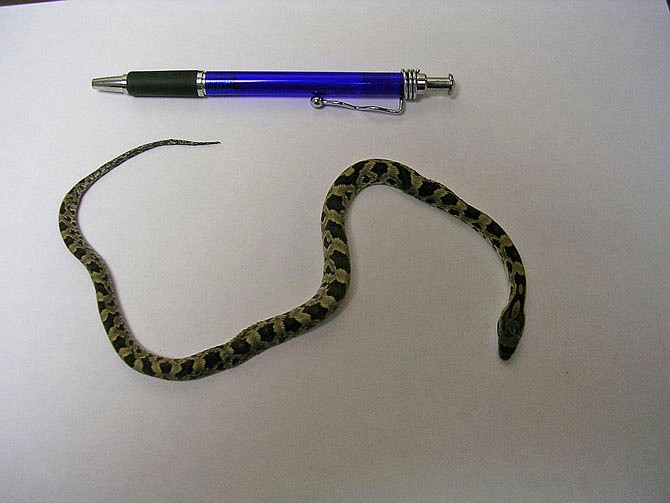Q. What is this small snake I found (see photo)?
A. This is a juvenile bull snake; adults are 4 feet or longer. Juvenile bullsnakes eat small lizards, frogs and baby mice. Bullsnakes kill their prey via constriction. The idea bullsnakes occasionally eat rattlesnakes is sometimes given as a reason for humans not to harm bullsnakes when encountering them in the wild, although a better reason is the bullsnake's role in controlling warm-blooded vermin such as rodents.
Q. I didn't get a chance to overseed my lawn in September, and it is full of crabgrass anyway. What can I do to make it look better next year?
A. You are likely too late to overseed now. Given the crabgrass is thick, it would struggle to emerge through it. Given that and the crabgrass should kill out from frost in October or early November, consider delaying your fall fertilization to November. To thicken the lawn, consider frost seeding in early February. If you are unfamiliar with this term, here is an online article on it: ipm.missouri.edu/MEG/2008/2/Late-Winter-Seeding-for-Home-Lawns-and-Selecting-Turfgrasses/.
You do have to wait until that grass germinates and gives you a nice stand before putting down a crabgrass preventer. While we advise crabgrass preventer between April 1-15, if delayed until May 1 it will still help a lot. Crabgrass preventer often has fertilizer with it; if so, it functions as your recommended second fertilization for cool season lawns of the fall and spring.
Q. I want to work up my vegetable garden and plant a cover crop. What are some good choices?
A. First, do not apply lime or wood ashes to an area where you grow vegetables, unless you have tested the soil to make sure it is desired. Four out of five soil samples for vegetable gardens have a pH too high, and lime and wood ashes both increase pH.
Buckwheat will grow very quickly, but it does frost kill. Oats are a good option, as they will tolerate frost, but eventually winter kills. If you want something that lasts through winter, then winter wheat, rye or annual ryegrass are good choices. Lastly, several Brassica crops work well; these include mustard, turnips and radish.
Q. I have a fairly shady area where I seeded grass and the grass fizzled out. Would it be worthwhile to test the soil?
A. Testing the soil may be helpful to whatever you plant. But the reason the grass didn't establish the last time may be the area is too shady. I like to see lawns get at least two hours of sun or be only moderately shady. If mostly in heavy shade with no sun, then ivy or some other shade-tolerant ground cover would be better.
The Central Missouri Master Gardeners are a volunteer group of 191 members, 122 of whom are Cole County residents, who maintain 11 beautification sites in Cole County, which are nonprofits or public entities. Master Gardeners must complete a basic training program of at least 30 hours of horticultural training, as well as 30 hours of volunteer service. The Missouri Master Gardener program is supported by the University of Missouri Extension.
Have a gardening question of your own? Call 634-2824 or stop by the Cole County Extension Center at 2436 Tanner Bridge Road.

